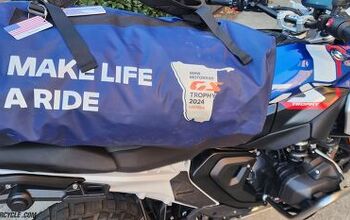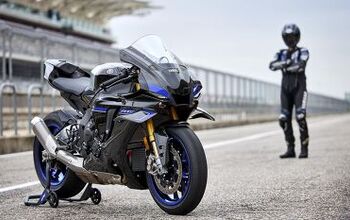What's the Right Motorcycle Helmet for Me? (Motorcycle Helmet 101)
There is a motorcycle helmet designed for every riding style on or off-road today, but what's the right one for you?
Choosing a helmet is an essential decision for any rider, and there's more to it than simply working within a budget or reaching for attractive graphics. Today's motorcyclist has a plethora of considerations, such as size, style, and construction, before deciding what they'll be placing on their heads. In this article, we'll be looking at the main things you need to be aware of when selecting the right helmet for you and your ride. Break your paper and pencil, kiddos! Welcome to Motorcycle Helmet 101.
Use Your Head: Style and Purpose
There truly is a helmet style for everyone and every type of riding. So, let's cover the main types of helmets on the market to help you make a more informed choice.
- Full-Face Helmet: A full-face helmet is unequaled in terms of impact protection and environmental protection. A conventional full-face helmet is typically the most aerodynamic, making it more comfortable at higher freeway speeds. A wide variety of full-face helmets are available, serving commuters, sport-tourers, racers, and everything in between.
- Modular Full-Face Helmet: Modular helmets are incredibly convenient, as they provide the protection and aerodynamics of a full-face with the convenience of an open-face helmet because the chin bar can be raised. Communicating, staying hydrated, and cooling off while stopped or at low speeds are all made easier with a modular helmet.
- Open-Face Helmet: An open-face helmet can be equipped with or without a faceshield but will still provide much more airflow than a full-face helmet due to its lack of a chin bar. These are great on scooters, cruisers, and motorcycles that might encourage a leisurely pace.
- Half Helmet: A half helmet is the least restrictive option available, though it provides the least protection.
- ADV Helmet: Adventure helmets are designed to be used on- and off-road, including features such as a peak and conventional faceshield. Many ADV offerings allow riders to remove the faceshield or raise it out of the way and use off-road goggles with the helmet. A wide variety of riding situations can be handled competently with an ADV-style helmet.
- Off-Road Helmet: These types of helmets are appealing because they're light, are equipped with peaks, and have massive ventilation. In addition, off-road helmets often have large viewports for unobstructed vision. They are best used when off-road riding is your focus.
Promoted Product: Shoei RF-1400
The Shoei RF-1400 helmet is the successor to the popular RF-1200, bringing numerous features that improve upon one of the Japanese manufacturer's most popular helmets. Compared to its predecessor, the RF-1400 boasts a 4% drag and 6% reduction in lift, offering superior ventilation with six air intakes (2 lower, 2 front, 2 upper) and four exhaust outlets. This full-face helmet utilizes an intermediate-oval shape and uses four unique shell sizes to accommodate a wide XS to XXL size range. Thanks to its aggressive aerodynamic profile and creature comforts, this versatile helmet can be used for touring, commuting, sport riding, track days, or even racing. Newly designed Emergency Quick Release System (E.Q.R.S.) sweat-wicking cheek pads now feature additional volume on the upper and lower sections, reducing wind noise considerably.
Protect your noggin at Dennis Kirk.
Check Your Fit: Size and Shape
Okay, so you know the helmet style that matches your needs. Now, let's discuss the most vital element in the helmet-buying process: Fitment.
Fitment influences everything from general comfort to your helmet's ability to absorb impacts. For example, a helmet that is too loose can move, obscure vision, and may reduce the efficacy of its impact-absorbing EPS (expanded polystyrene) foam liner. Likewise, a helmet that is too tight can distract riders with painful pressure points while restricting things like ventilation and blood flow.
Understanding how you fit into a helmet comes down to two main points: Size and head shape.
Let's start with size. All manufacturers publish a specific measurement range corresponding to a particular helmet size. Since these size ranges can change from brand to brand, riders must confirm their head measurements when trying various manufacturers.
Thankfully, most helmet makers suggest measuring head circumference similarly. All you'll need is a soft tape measure and it can be done on your own. However, if you're uncomfortable with this process, consult a trained representative from an authorized dealer who will be familiar with the measuring procedures. Follow these guidelines:
- Wrap a flexible measuring tape horizontally around the circumference of your head, roughly 1 inch above the eyebrows. Confirm the measurement by moving the tape up and down slightly to find the largest measurement.
- Cross-reference your measurement with the official sizing guidelines published by the respective helmet manufacturer.
- If your measurement is on the borderline between two sizes, try the smaller of the two sizes initially.
Before trying on any helmets, we need to discuss another critical element of fitment: Head shape. Head shape refers to the helmet's interior shape, which affects how the internal padding and EPS layers are designed. Remember, all our heads are a little different. An accurately measured helmet may fit nicely on one rider while creating uncomfortable pressure points on another, and that's due to its shape.
Determining your head shape is simple: Have someone observe or take a photo from a vantage point directly above your head. You can also use a mirror if you're doing this solo. Be sure to flatten your hair as best as possible so you have a clearer idea of your head's shape.
Most helmet makers produce three primary head shapes representing the riding market well. In addition, reputable manufacturers will cite each helmet's head shape to help customers determine a perfect fit. These shapes include:
- Round Oval: This shape accommodates riders with a head almost as wide as long, creating a comparatively round shape.
- Intermediate Oval: While like the round oval, the intermediate oval is slightly narrower side-to-side, resulting in a shape that's more ovalized. It's also the most popular shape in the North American market and, subsequently, a familiar shape offered by brands.
- Long Oval: This shape is the longest and narrowest of all common head shapes.
Now that we understand how to get our size and head shape, the only thing left to do is start trying on helmets. Ideally, a perfectly fitting helmet will require a bit of effort to pull on, fit snugly around the entire crown of your head, and allow your eyes to be located near the middle of the viewport to provide an optimal field of view.
Confirm fitment by performing a few basic tests. Ensure you cannot slide two fingers between the rider's temple and the helmet liner – again, things should be snug everywhere. Fasten the chinstrap properly and place one hand on either side of the helmet, then pull it in all directions (up, down, left, and right) without moving your head. While performing that action, the skin on your head and face should be pulled along with the helmet.
If the helmet is sliding around easily, it's probably too big. Another telltale sign of a helmet that's too large is that the helmet sags, and your eyes are located near the top of the viewport. Lastly, it may have been entirely too easy to put on. Conversely, a helmet that is too small will have the exact opposite results. Putting it on will be extremely difficult, and you will likely feel pressure points immediately. Also, your eyes will likely be located near the lower portion of the viewport.
We recommend wearing a helmet for 15 to 30 minutes to confirm potential discomfort before riding. Pressure points that might seem negligible initially can become unbearable relatively quickly. A tight fit is fine, especially on racetrack-oriented helmets, but you should never feel any meaningful discomfort. In addition, helmets do break in over time.
Note that many helmets feature adjustable interior padding, allowing owners to increase or decrease pad thickness throughout critical areas of the helmet, which can help achieve your preferred fit or alleviate minor fitment issues. For example, some racers often increase the thickness of their cheek pads to make their helmets even more stable.
Thank About Accessories
Helmets can be customized for many different roles, meaning you'll be riding in many different weather conditions or at various times of the day.
Riding in the rain, cold, or at night is best done with a clear face shield equipped with an anti-fogging device. Likewise, a darkened face shield is extremely helpful on brighter days but can obscure your vision at night.
Communication is also another topic of interest when purchasing a new helmet. Many helmets now feature pockets within the padding and EPS liners to comfortably accommodate communication devices. If you plan on using an intercom, it's always good to consider options for this type of accessory.
Lastly, features such as emergency quick-release systems for the interior padding are something to keep in mind. Several helmet manufacturers employ systems designed to help ease helmet removal from a downed rider, allowing emergency medical staff to render aid without injuring or further harming a rider's neck or spine. Remember, a properly fitted helmet will be snug on the rider's head, and pulling that off an injured individual could cause unintentional harm.
Doublecheck Safety Ratings
Any helmet legally sold within the United States must be Department of Transportation-compliant (DOT), which means it meets or exceeds the Federal Motor Vehicle Safety Standard (FMVSS) No. 218. DOT-compliant helmets feature a rear sticker displaying the following information: Manufacturer, model name, DOT, FMVSS No. 218, CERTIFIED.
In many cases, a helmet will feature one or more safety certifications, making it eligible to be sold simultaneously in several markets. Often, consumers will see the ECE22.06 standard set by the United Nations Economic Commission for Europe (UNECE).
SNELL (M2020D) is another common certification, though it is not set by any governing body. The Snell Foundation is an independent non-profit organization that performs helmet testing, and manufacturers can seek certification independently. Many racing organizations require Snell-certified helmets, but it is not legally necessary for helmets sold within the United States.
Recently, race-oriented helmets have begun featuring a newer Federation Internationale de Motocyclisme (FIM) helmet standard, FRHPhe-02, making them eligible for competition in world championships such as MotoGP and World Superbike. While this standard does not pertain to road riding, it is something to consider for budding racers.
Put A Lid On It!
Discovering what helmet is right for you encompasses a lot of different aspects. Budget and style are essential, but there are bigger things to think about. Above all else, understanding how to fit a helmet properly is an integral part of rider safety, as we all want our helmets to perform as well as they possibly can. Now that you know the guidelines for picking a helmet, we recommend working with an authorized dealer like our pals at Dennis Kirk. Class dismissed! Have any more questions? Leave them in the comments below.
Become a Motorcycle.com insider. Get the latest motorcycle news first by subscribing to our newsletter here.
More by Edward Narraca



































Comments
Join the conversation